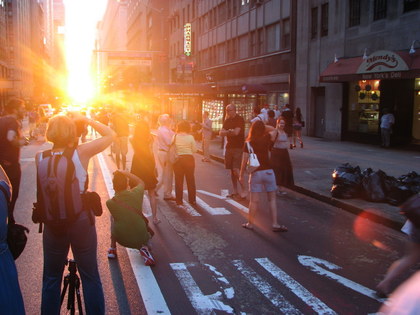
Musings
Manhattanhenge
Posted by Colin Higton
Sometimes, after we have carefully designed the latest brochure or website for a client, they will ask us to move an element of the design from one side of the page to another, or just to make something bigger.
It’s as easy as that to ask for – and in all honesty it isn’t a lot harder to do on the computer – but sometimes it leads to scratching of heads and even a bit of swearing here in the studio. It may end up taking an hour or two to make a change which could have been done in 10 minutes – and if you witness this process, you might find yourself asking why – and if you are paying the designer for their time you might legitimately ask why.
The answer to that was kind of illustrated in New York this week with a phenomenon they are calling‘Manhattanhenge’. In a city like New York with a clear grid structure and so many skyscrapers, every so often, the sun sets in line with the city’s streets so that it sets between the buildings instead of just disappearing behind them.
The effect is like Stonehenge – and as you can see from the photograph above, the New Yorkers who normally ignore their skyline stop – or even gather – to witness and photograph the event.
But what’s that got to do with layout I hear you ask?
The truth is that humans can’t help but see patterns in everything – from the stars and clouds to tea leaves and the landscape. In Manhattan as everywhere else, the sun sets every day, but when it suddenly lines up with a road between buildings, the whole event takes on a whole new significance.
But this isn’t just a passive thing – we don’t just notice the pattern, we actually look for it. We search for patterns in everything – and sometimes we attach huge importance to them – whether it’s the slice of toast with an image of Jesus on it or reading omens and portents into the alignment of the stars.
Cloudwatchers love to share the shapes they see – and if you get out a magic eye book in almost any group of people they will desperately try to ‘see the picture’ – even if they aren’t convinced it’s actually there. Finding patterns satisfies something deep within us.
And that’s the point – we may not always actually see the way items line up with and relate to each other on a page, but we instinctively know when they are right. It helps the viewer to read the page, and keeps comfortable and relaxed – even if the design is vibrant and busy.
The order and structure behind the design makes the difference between something that feels wrong and something that just works.
It isn’t always easy to find – but it’s always worth looking for, and it’s something we work really hard to find for our clients.
Back to the Blog